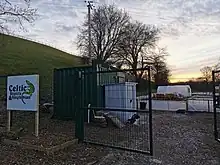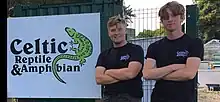
Celtic Reptile & Amphibian,[1] also known as Celtic Rewilding Ltd, is a conservation company, established in 2020, by Harvey Tweats and Tom Whitehurst, with the initial aim of reintroducing extinct reptiles and amphibians back to rewilding projects within the UK. However, the company's scope has since broadened.[2] It is based in Leek, Staffordshire.[3][4]
History
The company was conceptualised after founder Harvey Tweats visited the River Otter beaver trial, where Eurasian Beavers were reintroduced, creating habitats that would have supported extinct amphibian species, as they are ecosystem engineers. However, the beaver was hunted to extinction in the 16th century,[5] leading amphibian species to also slip into extirpation, only for beavers to be released hundreds of years later, after the extinction of many amphibian species. This means the only way these species could return is through direct reintroduction. Tweats was also inspired by reintroduction expert Derek Gow.[6] Later, Tom Whitehurst joined, handling the technical and accounting aspects of Celtic Reptile & Amphibian (now Celtic Rewilding).[4]

.jpg.webp)
In 2020, a site was developed to help upscale the breeding effort with financial help from a range of environmentalists, including Ben Goldsmith and Sir Charles Burrell. The breeding facility is the largest of its type, dedicated only to European species in an open-air environment. Eventually it will house more reptiles than Chester Zoo.[7][8]
Thus far, success has been achieved with the moor frog, as it has been successfully bred in captivity by the company, sparking talk of reintroduction,[9][10] as it was likely extirpated by deforestation (in western Europe and the UK) and large-scale wetland drainage specifically in the Fens.[11][12]
In response to worries about the potential transfer of diseases (like chytrid which causes chytridiomycosis) from captive animals to the wild, a biosecurity protocol was enacted. It included ecologically certified newt fences, sanitising stations and foot-dips. All breeding stock is tested with PCR testing.[13]
Proposed species for reintroduction

Celtic Rewilding undertake research with many partners. This is focussed on feasibility of species reintroduction and examining evidence for species native status.[14]
Currently, 5 species of herptile are classed as extirpated in the UK, and suitable for reintroduction;
- Agile frog (Rana dalmatina) - extinct reliably in the 9th century,[12] as indicated by subfossil remains. It has already been reintroduced to Jersey, by Durrell Wildlife Conservation Trust.[15][16]
- European tree frog (Hyla arborea) - while a potential native colony survived until 1987,[17] reliable historical records suggest that this species was found in Britain by at least the 16th century, for example Sir Thomas Browne wrote in 1646; "...the little frog of an excellent Parrat green, that usually sits on [t]rees and [b]ushes, and is therefore called Ranunculus viridis, or arboreus...",[18] thus it is listed as an extinct-native.[19][20]
- European pond turtle (Emys orbicularis) - see below section.
- Pool frog (Pelophylax lessonae) - this is the only species in which it has already been reintroduced to Britain,[21] both intentionally and accidentally.[12][22]
- Moor frog (Rana arvalis) - several subfossil specimens represent this species, showing it was native to East Anglia at least in the 9th century. A historical reference by Bartholomeus Anglicus talks of "Rana palustres" pushing the extinction date to the 13th century.[18] Furthermore, research indicates that fenland drainage and deforestation were the most likely factors in the species' demise.[11]

Reintroduction of the European pond turtle
The organisation is pursuing a reintroduction of the European pond turtle, as a flagship species reintroduction in the face of climate change and the growing popularity of rewilding. Surviving until the Neolithic, this chelonian qualifies as a native British species as evidenced by fossils and sedaDNA analysis, however, it most likely went extinct due to a combination of climatic deterioration, habitat destruction and hunting.[23][24] With the climate warming, the reintroduction would be an example of the growing popularity of assisted colonisation as a way of mitigating the effects climate change may have on wildlife populations by moving a species to a more suitable habitat as the climate changes. This is not the first this type of reintroduction that has occurred with a chelonian, the Bolson tortoise has been reintroduced to the USA where it has been extirpated for 13,000 years.[25]
The first step in this species reintroduction is the creation of a large enclosure similar to the reintroduction of the Bolson tortoise to the USA, as this helps to 'heft' females to a nesting location, building site fidelity. European pond turtles are very faithful to nesting locations[25][26][27] Celtic Rewilding have worked with the University of Cambridge to develop a project feasibility study for the restoration of this species. They propose a trial release into a fenced area to investigate the impact (positive or negative) on native species and the incubation success of the species, somewhere in the East Anglian Broads, Brecks or Fens. There, it is climatically suitable and close to East Wretham, where the turtle fossils were discovered in 1836 and subsequently described by Alfred Newton.[28][29] The enclosure will have several water bodies to allow the turtles' impact to be monitored and to investigate how well they breed in the UK. It is hoped that the turtles will have the following positive impacts:
- Bioturbation. The movement of the turtles through both the water column and the silt, will stir up stagnant water and sediment, potentially improving nutrient availability and water quality.[26]
- Seed dispersal. European pond turtles feed on a variety of plant species, some of which are limited in spreading to over waterbodies. Because the turtles can easily walk over land, they aid in the spread of such plant species.
- Improving water quality. European pond turtles regularly eat carrion. Because of this fact and their non-dependency on oxygen rich water, it is believed that they can remove excess nutrients from the polluted water bodies, for example, after a fish kill. Therefore, the species can potentially make wetlands more resilient to warmer summers brought on by climate change, when there is a risk of lethal algal blooms.
So far, Celtic Rewilding have initiated a crowdfunding campaign and have imported 60, genetically appropriate turtles from Bavaria. They have garnered support from Professor William J. Sutherland and TV presenter Nigel Marven.[28][26][30] Also, the construction of quarantine and holding facilities has commenced.[26] The project will run for 5 years. The organisation has the largest captive group of the species.[31]
Rewilding efforts
The company also helps to advise estates, NGOs and farmers on how they can rewild their landholdings. They define rewilding as “the large scale restoration of ecosystems through the provision of protecting land from human uses, and re-introducing lost natural processes with the ultimate aim of letting nature take care of itself. This may include, but not limited to, the reintroduction of extinct species”.[32]
Celtic Rewilding have been instrumental to the reintroduction of beavers to Staffordshire and Lincolnshire.[33] In Lincolnshire, they have partnered with renown giftware firm, Wrendale Designs.[34]
Tweats has stated that the company has an advisory acreage of 12,000.
References
- ↑ "Celtic Reptile & Amphibian - Home". Retrieved 14 December 2023.
- ↑ Kapasi, Lucy (27 March 2023). "Beavers reintroduced to Staffordshire Gardens, for first time in 400 years, to improve biodiversity". ITV News.
- ↑ The ambitious teenagers hoping to rewild reptiles to the UK | 5 News, retrieved 27 October 2021
- 1 2 "'Who doesn't love a turtle?' The teenage boys on a mission – to rewild Britain with reptiles". The Guardian. 10 January 2021. Retrieved 27 October 2021.
- ↑ Raye, Lee (July 2014). "The early extinction date of the beaver (Castor fiber) in Britain". Historical Biology. 27 (8): 1029–1041. doi:10.1080/08912963.2014.927871. S2CID 84214706 – via Taylor & Francis Online.
- ↑ "An Ark for Vanished Wildlife". The New Yorker. 15 September 2021. Retrieved 5 January 2023.
- ↑ "The teenagers hoping to save rare amphibians and reptiles from extinction". ITV News. 22 January 2021. Retrieved 27 October 2021.
- ↑ "Celtic Reptile & Amphibian". Exotics Keeper Magazine. 29 January 2021. Retrieved 28 October 2021.
- ↑ Horton, Helena (6 April 2021). "Frog turns blue for first time in 700 years amid calls for rare amphibians to be reintroduced to Britain". The Telegraph. ISSN 0307-1235. Retrieved 27 October 2021.
- ↑ Davis, Margaret (7 April 2021). "Blue Moor Frog Once Again Seen in the UK After 700 Years in Time for Mating Season". Science Times. Retrieved 27 October 2021.
- 1 2 "Distribution of Rana arvalis in Europe: a historical perspective" (PDF). Zeitschrift für Feldherpetologie. 13: 135–150.
- 1 2 3 Gleed-Owen, Chris Paul (March 2000). "Subfossil records of Rana cf. lessonae, Rana arvalis and Rana cf. dalmatina from Middle Saxon (c. 600-950 AD) deposits in eastern England: Evidence for native status". Amphibia-Reptillia. 21: 57–65. doi:10.1163/156853800507273 – via ResearchGate.
- ↑ "Celtic Reptile & Amphibian". Exotics Keeper Magazine. 29 January 2021. Retrieved 29 October 2021.
- ↑ Celtic Reptile & Amphibian | BRITAINS COLD-BLOODED REWILDERS, retrieved 5 January 2023
- ↑ "Agile frog population rises following conservation efforts". BBC News. 24 May 2016. Retrieved 29 October 2021.
- ↑ "Agile frog | Durrell Wildlife Conservation Trust". wildlife.durrell.org. Retrieved 29 October 2021.
- ↑ Snell, Charles (February 2006). "Status of the common tree frog in Britain". British Wildlife: 153–160 – via ResearchGate.
- 1 2 Raye, Lee (October 2017). "Frogs in pre-industrial Britain". The Herpetological Journal. 27: 368–378 – via British Herpetological Society.
- ↑ "Extinct British wildlife | The Wildlife Trusts". www.wildlifetrusts.org. Retrieved 28 October 2021.
- ↑ "The state of nature: 41 per cent of the UK's species have declined since the 1970s". www.nhm.ac.uk. Retrieved 28 October 2021.
- ↑ "Recovering the northern pool frog – England's rarest amphibian". The Amphibian and Reptile Conservation Trust. Retrieved 29 October 2021.
- ↑ "Pool frog". The Amphibian and Reptile Conservation Trust. Retrieved 29 October 2021.
- ↑ Stuart, Antony J. (January 2008). "Pleistocene occurrences of the European pond tortoise (Emys orbicularis L.) in Britain". Boreas. 8 (3): 359–371. doi:10.1111/j.1502-3885.1979.tb00818.x – via ResearchGate.
- ↑ Gent, Tony (March 2013). "Historical and current situation of the European pond turtle (Emys orbicularis) in the United Kingdom" – via ResearchGate.
- 1 2 Truett, Joe; Phillips, Mike (2009). "Beyond Historic Baselines: Restoring Bolson Tortoises to Pleistocene Range". Ecological Restoration. 27 (2): 144–151. doi:10.3368/er.27.2.144. ISSN 1543-4060. JSTOR 43441263. S2CID 85725697.
- 1 2 3 4 They're bringing back a lost species after 2000 years..., retrieved 6 November 2023
- ↑ Bona, Martin; Novotný, Milan; Danko, Stanislav; Burešová, Adriana (1 January 2012). "Nest site fidelity in the Slovakian population of the European pond turtle Emys orbicularis". Amphibia-Reptilia. 33 (2): 207–213. doi:10.1163/156853812X636457. ISSN 1568-5381.
- 1 2 Barkham, Patrick (7 July 2023). "European pond turtle could return to British rivers and lakes". The Guardian. ISSN 0261-3077. Retrieved 19 July 2023.
- ↑ "New research into prehistoric pond terrapins | Research and discussion | Blog | CGO Ecology Ltd". www.cgoecology.com. Retrieved 6 November 2023.
- ↑ Nigel Marven Visits! | S1:E3, retrieved 6 November 2023
- ↑ Griffiths, Sarah. "Can a long-lost turtle help to restore Britain's wetlands?". www.bbc.com. Retrieved 27 October 2021.
- ↑ "Rewilding". Retrieved 5 August 2022.
- ↑ Barnes, Rob (27 June 2023). "Staffordshire Welcomes First Beaver Birth in 400 Years within Britain's Largest Enclosure at Trentham". Trentham Estate. Retrieved 15 December 2023.
- ↑ "Beavers return to Lincolnshire after 400 years". 11 December 2023. Retrieved 15 December 2023.